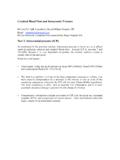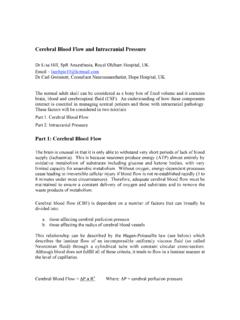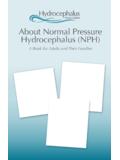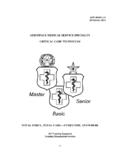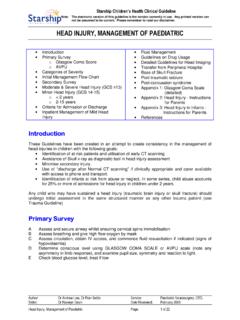Transcription of Autism, Sleep Disordered Breathing, and …
1 The ASD/OSA Hypothesis MEDICAL HYPOTHESES AND RESEARCH, VOL. 9, NO. 1, JANUARY 2014 1 D. E. Wardly [2014] Med. Hypotheses Res. 9: 1-33. autism , Sleep Disordered breathing , and Intracranial Hypertension: The Circumstantial Evidence D. E. Wardly* 7901 Autumn Gate Avenue, Las Vegas, NV 89131, USA Abstract. The ASD/OSA hypothesis as proposed in this paper will incorporate over 90 pieces of the " autism puzzle". It is suggested that the cause of autism is four-fold, requiring that: 1) the mother has Sleep Disordered breathing (SDB) during her pregnancy, 2) the infant is born with Sleep Disordered breathing , 3) both mother and infant have polymorphisms of the methylation pathway which are then triggered by the SDB, and 4) the infant is prone to intracranial hypertension.
2 This theory can explain many, if not most, of the pieces of information that we currently know about the biology of autism . The fact that the Sleep Disordered breathing (SDB) in autism and in the mothers of autistic children has not been previously noted is due to flaws in the current methods for detecting SDB. Esophageal manometry is much more sensitive for detecting SDB but is not used routinely, however it may be more accurate than the apnea hypopnea index in terms of correlation with disruptive behavior disorders. There is evidence that SDB is much more common than previously believed.
3 Apneas are known to increase intracranial pressure, and intracranial hypertension can be caused by obstructive Sleep apnea. Recent studies showing behavioral problems and special needs correlated with SDB urge further evaluation of autistic children for SDB. The ASD/OSA hypothesis suggests that autism might be primarily prevented by detecting and treating SDB in women prior to conception, and in infants shortly after birth. Correspondence: Dr. Deborah E. Wardly, 7901 Autumn Gate Avenue, Las Vegas, NV 89131, USA.
4 PHONE: 916-712-0704. FAX: 505-212-1712. E-MAIL: Received on May 10, 2013; accepted on October 30, 2013. REVIEW & HYPOTHESIS D. E. WARDLY MEDICAL HYPOTHESES AND RESEARCH, VOL. 9, NO. 1, JANUARY 2014 2 1. Introduction Sleep Disordered breathing There has been a great deal of scientific investigation over recent years into possi-ble causes for autism , and speculation regarding the increase in diagnosis seen since the early 1990s. We have learned many things which define the biology of autism and fuel the fire for those of us searching for a cure.
5 There is the analogy of the puzzle piece for each of these items, with the hope that they can be used to construct a clear picture of cause and cure. We hold the pieces this way and that to see how they fit together. This author believes that they are beginning to show a picture that makes sense, we just need to have a particular framework to fit them into so that we can see it. Like an opti-cal illusion, a trick of the light and the way your eyes focus can change what you see. This paper will discuss many of the pieces we have, show the reader how to focus their eyes differently, and ultimately attempt to construct at least part of the puzzle so that we can see the picture it represents.
6 autism is a spectrum disorder characterized by deficits in language, social com-munication, and restricted and repetitive behaviors. It has been demonstrated that ob-structive Sleep apnea (OSA) can be an underlying factor in autism [1], and we know that up to 83% of those with autism spectrum disorders (ASD) can have significant Sleep disturbance [2]. This paper will argue for the hypothesis that Sleep Disordered breathing (SDB) may be the underlying trigger in most cases of idiopathic autism .
7 That this has gone unrecognized before now is likely due to the fact that the diagnostic tools used in Sleep medicine lack standardization and most Sleep labs do not use the methods required to detect mild Sleep Disordered breathing . 2. Obstructive Sleep Apnea Obstructive Sleep apnea in adults is defined as a collapse of the upper airway lead-ing to cessation of breathing (apnea) or significant diminished breathing (hypopnea) for more than 10 seconds, with these events occurring at least 5 times per hour. This will generate the AHI, or apnea hypopnea index, and the apnea may lead to intermittent hypoxia [3].
8 In children, an AHI >1 is considered abnormal. Apnea in children has been defined as the absence of airflow with continued chest wall and abdominal wall move-ment for a duration longer than 2 breaths. Hypopnea in children has been defined as a decrease in nasal flow between 30% and 80% from baseline with a corresponding de-crease in oxygen saturation of 3% and/or an arousal. Children with OSA do not always have a cortical arousal associated with obstructive events and are less likely to have fragmented Sleep compared to adults.
9 The majority of their events occur during REM Sleep , and they may present with persistent obstructive hypoventilation with snoring and labored breathing rather than the pauses and gasps associated with complete air-way collapse [4]. The symptoms of OSA in children can be subtle and not always rec-ognized by parents. Children may mouth breathe and hyperextend their necks in Sleep to compensate for their airway problems and this will reduce snoring [5]. Daytime symptoms of OSA may include mouth breathing , nasal obstruction, morning headache, daytime sleepiness and trouble concentrating [6].
10 The ASD/OSA Hypothesis MEDICAL HYPOTHESES AND RESEARCH, VOL. 9, NO. 1, JANUARY 2014 3 3. Upper Airway Resistance Syndrome Upper airway resistance syndrome (UARS), a mild form of SDB that many doc-tors are not even aware of, can actually cause more significant symptoms than OSA. UARS was first described in 1982 but the term was not coined until 1993 [7]. It occurs when a person arouses prior to complete airway collapse, due to the upper airway re-sistance. On polysomnogram (PSG) the AHI is less than 5, the oxygen saturation is not below 92%, and there are frequent RERAs (respiratory event related arousals) and other nonapnea/hypopnea respiratory events.
